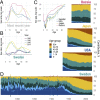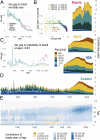Death rates at specific life stages mold the sex gap in life expectancy
- PMID: 33972417
- PMCID: PMC8157960
- DOI: 10.1073/pnas.2010588118
Death rates at specific life stages mold the sex gap in life expectancy
Abstract
Why do women live longer than men? Here, we mine rich lodes of demographic data to reveal that lower female mortality at particular ages is decisive-and that the important ages changed around 1950. Earlier, excess mortality among baby boys was crucial; afterward, the gap largely resulted from elevated mortality among men 60+. Young males bear modest responsibility for the sex gap in life expectancy: Depending on the country and time, their mortality accounts for less than a quarter and often less than a 10th of the gap. Understanding the impact on life expectancy of differences between male and female risks of death by age, over time, and across populations yields insights for research on how the lives of men and women differ.
Keywords: decomposition; life expectancy; sex gap.
Copyright © 2021 the Author(s). Published by PNAS.
Conflict of interest statement
The authors declare no competing interest.
Figures


Similar articles
-
The changing gender differences in life expectancy in Korea 1970-2005.Soc Sci Med. 2012 Oct;75(7):1280-7. doi: 10.1016/j.socscimed.2012.04.026. Epub 2012 May 23. Soc Sci Med. 2012. PMID: 22739261
-
Age-specific and sex-specific mortality in 187 countries, 1970-2010: a systematic analysis for the Global Burden of Disease Study 2010.Lancet. 2012 Dec 15;380(9859):2071-94. doi: 10.1016/S0140-6736(12)61719-X. Lancet. 2012. PMID: 23245603
-
[The changing sex differences in life expectancy in Spain (1980-2012): decomposition by age and cause].Gac Sanit. 2018 Mar-Apr;32(2):151-157. doi: 10.1016/j.gaceta.2017.03.004. Epub 2017 May 19. Gac Sanit. 2018. PMID: 28529096 Spanish.
-
Disparities in length of life across developed countries: measuring and decomposing changes over time within and between country groups.Popul Health Metr. 2016 Aug 11;14:29. doi: 10.1186/s12963-016-0094-0. eCollection 2016. Popul Health Metr. 2016. PMID: 27524940 Free PMC article.
-
Changing mortality patterns in East and West Germany and Poland. II: short-term trends during transition and in the 1990s.J Epidemiol Community Health. 2000 Dec;54(12):899-906. doi: 10.1136/jech.54.12.899. J Epidemiol Community Health. 2000. PMID: 11076985 Free PMC article.
Cited by
-
Searching for Beauty and Health: Aging in Women, Nutrition, and the Secret in Telomeres.Nutrients. 2024 Sep 15;16(18):3111. doi: 10.3390/nu16183111. Nutrients. 2024. PMID: 39339711 Free PMC article. Review.
-
Gender equality related to gender differences in life expectancy across the globe gender equality and life expectancy.PLOS Glob Public Health. 2023 Mar 6;3(3):e0001214. doi: 10.1371/journal.pgph.0001214. eCollection 2023. PLOS Glob Public Health. 2023. PMID: 36963039 Free PMC article.
-
Sex differences in cause-specific mortality: regional trends in seven European countries, 1996-2019.Eur J Public Health. 2023 Dec 9;33(6):1052-1059. doi: 10.1093/eurpub/ckad111. Eur J Public Health. 2023. PMID: 37507140 Free PMC article.
-
Gender-Related Characterization of Acne in Chinese: A Multiple-Center Cross-Sectional Survey on 13085 Cases.Clin Cosmet Investig Dermatol. 2024 Dec 20;17:3013-3021. doi: 10.2147/CCID.S484957. eCollection 2024. Clin Cosmet Investig Dermatol. 2024. PMID: 39720093 Free PMC article.
-
Trends of the burden of type 2 diabetes mellitus attributable to high body mass index from 1990 to 2019 in China.Front Endocrinol (Lausanne). 2023 May 31;14:1193884. doi: 10.3389/fendo.2023.1193884. eCollection 2023. Front Endocrinol (Lausanne). 2023. PMID: 37324264 Free PMC article.
References
-
- Assari S., If men are favored in our society, why do they die younger than women? The Conversation, 8 March 2017. https://theconversation.com/if-men-are-favored-in-our-society-why-do-the.... Accessed 19 April 2021.
-
- Shmerling R. H., “Why men often die earlier than women” Harvard Medical School–Health Blog (2016). https://www.health.harvard.edu/blog/why-men-often-die-earlier-than-women.... Accessed 19 April 2021.
-
- Austad S. N., “Sex differences in longevity and aging” in Handbook of the Biology of Aging, Masoro E. J., Austad S. N., Eds. (Elsevier, ed. 7, 2011), pp. 479–495.
-
- Legato M. J., Why Men Die First: How to Lengthen Your Lifespan (Palgrave Macmillan, 2008).
-
- Wilson M., Daly M., Competitiveness, risk taking, and violence: The young male syndrome. Ethol. Sociobiol. 6, 59–73 (1985).
Publication types
MeSH terms
Grants and funding
LinkOut - more resources
Full Text Sources
Other Literature Sources
Medical
Miscellaneous

